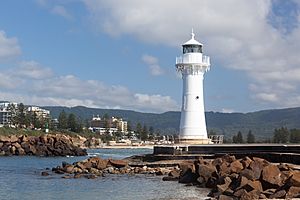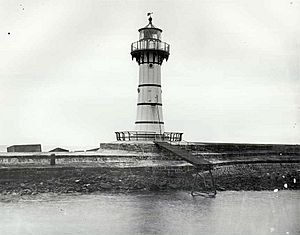Wollongong Breakwater Lighthouse facts for kids
 |
|
| Wollongong Breakwater Lighthouse | |
|
|
|
| Location | Belmore Basin, Wollongong, New South Wales, Australia |
|---|---|
| Coordinates | 34°25′11″S 150°54′24″E / 34.419660°S 150.906760°E |
| Year first constructed | 1872 |
| Deactivated | 1974 |
| Foundation | Ferro-concrete |
| Construction | Wrought iron tower |
| Tower shape | Tapered cylindrical tower with balcony and lantern |
| Markings / pattern | White tower and lantern |
| Height | 12.8 metres (42 ft) |
| Focal height | 17.1 metres (56 ft) |
| Intensity | 1000 cd |
| Range | 10 nautical miles (19 km; 12 mi) |
| Characteristic | Fl (3) WR 20s. |
| ARLHS number | AUS-172 |
The Wollongong Breakwater Lighthouse is a historic lighthouse in Wollongong, New South Wales, Australia. It is also known as the Wollongong Harbour Lighthouse. This special building stands on the southern breakwater of Wollongong Harbour.
Wollongong is unique because it is the only place on Australia's east coast with two lighthouses close to each other. The other one is the Wollongong Head Lighthouse. Even though the Breakwater Lighthouse is not used every day anymore, it was fixed up in 2002. It is now an official local heritage building.
Wollongong Harbour is a busy place. It is home to many private boats and the local fishing fleet. Nearby, Port Kembla is a big harbour for steel, minerals, and other goods. There are also islands called The Five Islands close to the coast. These islands can be dangerous for ships, which is why lighthouses are so important!
Contents
A Look Back: The Lighthouse Story
The Wollongong Breakwater Lighthouse is often called the "Old Wollongong Lighthouse" by local people. It was built in 1871. Before that, in 1866, the Wollongong Council asked for a lighthouse. They wanted to help sailors find their way safely into Wollongong port. This was very important during the early days of the coal industry in the Illawarra area.
The lighthouse stands on the southern breakwater. You can easily walk from it to its newer partner, the Wollongong Head Lighthouse.
How the Lighthouse Was Built
The lighthouse was designed by Edward Orpen Moriarty. He was a clever engineer for harbours and rivers. The tower is made of strong wrought iron. It sits on a base of ferro-concrete. This design helps it stand strong against big storms.
This lighthouse is one of only two in New South Wales made from wrought iron plates. The other one, Warden Head Light, was first built in Ulladulla. Building the Wollongong lighthouse was tricky because of rough seas. But the tower was strong enough to survive!
Before the lighthouse was ready, a temporary red light was used. It was placed in a box at the end of the pier. The main light was put in place in July 1871. However, it did not shine regularly until January 1872.
Why the Lighthouse Needed Saving
In 1937, a second lighthouse was built. This was the Wollongong Head Lighthouse. It was built on Flagstaff Point, south of the Breakwater.
Over the years, the wrought iron plates of the Breakwater Lighthouse were not looked after well. Its supports and base became very weak. In the 1970s, people thought the lighthouse was unsafe. They even planned to pull it down! Because of this, the Wollongong Head Lighthouse took over as the main lighthouse in 1974. The old Breakwater Lighthouse was turned off.
But the people of Wollongong wanted to save their old lighthouse! In 1974, and again in 2002, local groups helped fix it up. The old lighthouse is now a symbol of Wollongong. It shows an important part of the city's history. You can often see it on tourist brochures. It even appears on the uniform pocket of a local high school!
Even though the Wollongong Breakwater Lighthouse is not used all the time, its lights can be turned on. They are lit up for special events related to the sea.
A Special Heritage Building
The Wollongong Breakwater Lighthouse was officially listed as a local heritage building on January 7, 2000. It is important because it was Australia's first lighthouse made from steel parts built somewhere else and then put together on site. This shows how clever people were back then. They used new building ideas for new projects like lighthouses.
Images for kids






